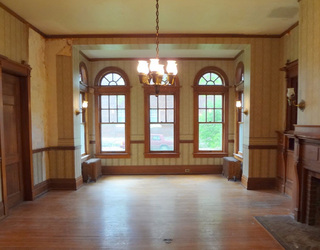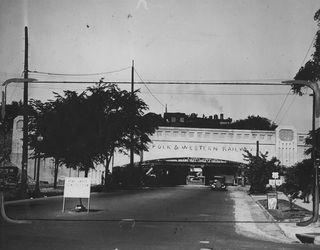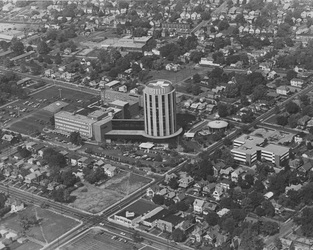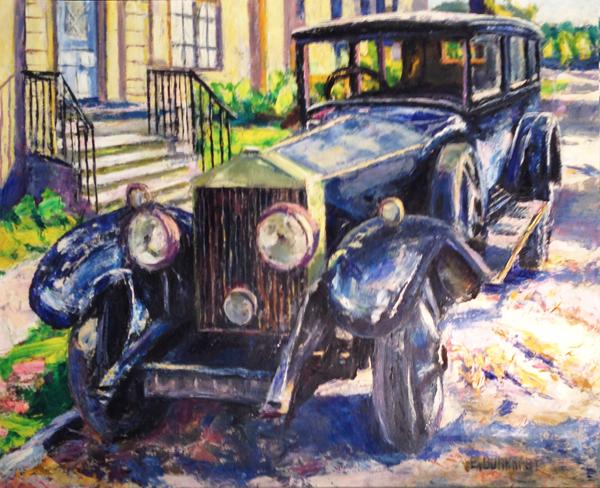A historical scrapbook of the Woodland Park neighborhood in Columbus, Ohio.
Woodland Park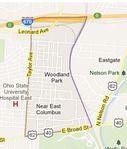
The Woodland Park neighborhood encompasses about 300 homes, a dozen-or-so apartment buildings, the condominiums of Park Towers and historic Brunson Place, three churches, two school buildings and a few commercial edifices.
Woodland Park is just as conveniently located to downtown as it was over 100 years ago. The neighborhood abuts the 100 acres of Franklin Park on the south and OSU East Hospital to the west. Taylor Avenue offers quick access to Interstate 670 and Broad Street with easy connections to the rest of the city. Columbus Metropolitan Airport is just a few minutes away. As varied as the homes of Woodland Park, also are the residents. People of all colors, backgrounds, lifestyles, and incomes reside in the neighborhood. Famous Residents
The finest homes of Woodland Park were built for the wealthy and upper middle class of Columbus of the early 20th century which included artists, journalists, attorneys, judges, teachers, architects, industrialists, and legislators who shaped Columbus.
While many are no longer household names, they were well known in their day. Emerson Burkhart (artist), Billy Ireland and Leland McClelland (cartoonists), May Elizabeth Cook (sculptor), Edward Taylor and John Martin Vorys (Congressmen), Henry Goddard (psychologist), August Koerbling (early aviator) and William N. Cleveland (bridge builder and nephew of President Grover Cleveland). John Marion Sheets (Ohio Attorney General); Attorneys Hugh Huntington, Campbell Voorhees, Webb I. Vorys, Lowry F. Sater, Augustus T. Seymour; coal barons Edward Johnson, Winfield S. Courtright and Harry B. Olmsted. Industrialists and retailers William Miller (shoes), Henry C. Werner (shoes), Jonas McCune (hardware), William Monypeny (wholesale groceries), W.S. Carlile (furniture), Frank Stallman (trunks), Eugene Reed (telephone), John Beals Brown (carriage lamps), Max Morehouse (department store). Leland "Larry" McPhail (Manager of the Cincinnati Reds, President of the Brooklyn Dodgers and the New York Yankees), Edward Schoenborn (owner of the Boston Red Sox). Architects Clarence E. Richards, Joel McCarty, George H. Bulford, and Robert Gilmore Hanford all had homes in Woodland Park. These are just a few of the noteworthy people who called the neighborhood their home. Woodland Park was also home of the East End Tennis Club, later known as the Columbus Tennis Club, on East Long Street. SubdivisionsWoodland Park was parceled out in a number of different additions and subdivisions. Each subdivision has a copy of the original plat map, if available.
Refugee Lands 1/2 Section 15 M.R. Kerney's First Addition Nelson's Heirs (1869) Cornfield's Addition (1875) P.V.N. Myers' Eastwood Addition (1877) Hannah M. Taylor's Addition (1883) Nelson Place Addition (1885) W.B. Hayden's Addition (1888) Charles E. Munson's Woodland Avenue Addition (1888) Calender and Rockwell's Subdivision (1888) Clifton Park Addition (1889) Charles E. Morris' Subdivision (1889) Woodlands (1889, 1890) Watson and Ryan's Subdivision of 1889 Woodland Place Addition (1890) Ryland's Woodland Place Addition (1892) Huling, Sherwood and Wirth's Norfolk Addition (1892) Watson and Ryan's Subdivision of 1893 A.R. Creamer's Subdivision (1894) Stone's Broad St. and Woodland Ave. Subdivision (1895) Smith's Woodland Park Addition (1900) D.D. Bolenbaugh as Trustee Subdivision (1901, 1909) L.B. Tussing Trustee Subdivision (1902) Smith's Second Woodland Park Addition (1903) William Monypeny Administrator's Subdivision (1907) Joel E. McCarty's Subdivision (1907) Maryland Terrace Addition (1909) Van Sickle's Emelco Addition (1909) Koontz and Dusenberry's Woodland Ave. Addition (1910) Raymond E. Rusk Subdivision (1916) Snider-Powell Subdivision (1917) Old MapsCaldwell's Atlas (1872)
Baist's Real Estate Atlas (1899, 1910, 1920) Modie & Kilmer’s Folio Atlas (1910) Franklin Survey Plat Book (1937) |
History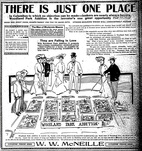
A streetcar suburb, Woodland Park was served by the Long Street and Mt. Vernon Avenue Street car lines. The Long Street line terminated at Broad Street and Parkwood Avenue. The neighborhood grew slowly in the 1890s with homes rapidly filling in the area at the turn of the twentieth century, many being built between 1900 and 1910. Building slowed, but continued through the 1920s.
Over the course of the early 20th century, a number of nearby retail establishments were walkable for the residents of Woodland Park, including a small grocers, barbers, shoe repairs, bakers and confectioners, cleaners, gas stations, even a saloon, billiards parlor and a sporting goods store. In 1960 a Kroger store was built on Greenway Avenue. There were also several manufacturing and commercial businesses and institutions in Woodland Park. Even as Woodland Park was filling out, some residents were building new homes in Bullitt Park, part of the area that would become Bexley in 1908. The allure of a bigger, better, newer house coupled with the rise of the automobile, was the start of a barely perceptible decline. Just as now, newer has the cachet of being "better." In the early 1920s some residents added deed restrictions to prevent African Americans from buying or renting homes in Woodland Park. These restrictions were ruled by the courts to be unenforceable in 1948, and within a few short years, between 1946 and 1950, Woodland Park had changed from a predominantly white neighborhood to primarily African American. The "white flight" of the era, combined with the allure of new suburbs, the post-war housing boom, new highways, cheap automobiles and the demise of the streetcar in Columbus, created a large influx of new residents. With the new residents came new uses of the large homes in the neighborhood. The largest mansions were used as apartments, offices or nursing homes. The Broad Street median featuring trees lining the road from the Capitol to Franklin Park had long ago been removed to add more traffic lanes. The mansions of Broad Street were rezoned commercial, and many became offices or were razed in the 1960s and 70s. These infrastructure changes altered the character of the neighborhood. Woodland Park lost some of its architectural heritage during this time and even through the 1990s. Fine homes were razed for parking lots, office buildings and new apartments, but much still remains. There are still vacant homes and opportunities for restoration and improvement in the neighborhood. Architecture
From Queen Annes of the 1890s to a Lustron home of the late 1940s, mansion to matchbox, Woodland Park has a rich architectural heritage.
The styles represented in Woodland Park include Queen Anne, American Foursquare, English Tudor, Federal and Georgian Colonial, Prairie Style, French Eclectic, American Craftsman and Mission, Cape Cod, Colonial Revival and Dutch Colonial Revival. Many properties in the neighborhood have irreplaceable unique details, many locally crafted, such as leaded and stained glass windows, ornate mantlepieces, fine wood trim, carved newel posts and balusters, pocket doors, solid brass hardware, art tile, carriage houses, large porches, and slate roofs, all combined with solid brick and stone construction. Documentary FilmClick this link for the website for information on the Woodland Park documentary film project. This link shows a short promotional video about the project on YouTube.
OTENA Tour of HomesThe Olde Towne East Tour of Historic Homes took place in Woodland Park in 2015 and is scheduled to be featured again in 2020. Visit the Olde Towne East Neighborhood Association (OTENA) website at oldetowneeast.org for more information on their annual tours of historic homes.
|
